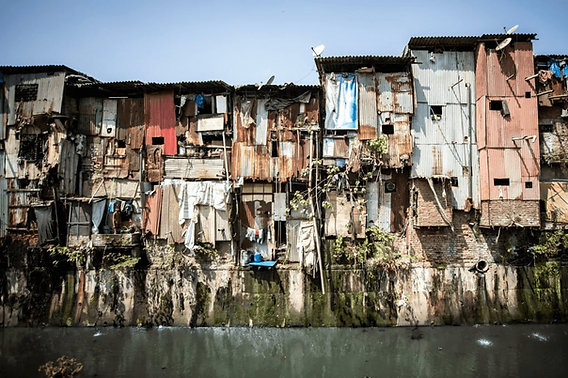Dharavi, Mumbai: A City of Dreams, Struggles, and Unbreakable Spirit
In the heart of Mumbai, hidden behind glass towers and luxury apartments, lies a world that defies every stereotype—a world that refuses to be crushed by hardship and works harder than the rest of the city, yet remains overlooked. Welcome to Dharavi, Asia’s largest slum and Mumbai’s beating heart, where over a million people live, dream, and struggle within just 2.1 square kilometers.
From a distance, Dharavi may appear to be a maze of tin-roofed houses, narrow alleys, and overcrowded streets. But step inside, and you will discover something extraordinary—a billion-dollar economy, a powerhouse of innovation, and a community that never backs down. Dharavi is not just a slum; it is a survival factory, producing everything from leather goods, pottery, and textiles to recycled plastic, food products, and handicrafts. It is a place where nothing goes to waste, where every scrap of plastic and metal is transformed into something valuable, and where people create opportunities from the most unlikely circumstances.
The Forgotten Backbone of Mumbai
Dharavi is not merely a settlement but the backbone of Mumbai’s economy. While the city's wealthy reside in skyscrapers built by the labor of the less fortunate, the people of Dharavi wake up each day to work in over 15,000 small-scale industries that generate nearly $1 billion in annual revenue. Yet, despite their contributions, they remain invisible to the government, overlooked by policymakers, and abandoned by the very system they sustain.
The leather industry in Dharavi is world-renowned, producing high-quality products that are exported to international markets. The pottery artisans of Kumbharwada carry forward centuries-old traditions, crafting beautiful earthenware used throughout the country. The textile industry employs thousands in tiny, dimly lit workshops where skilled hands create fabrics, embroidery, and garments that ultimately find their way to showrooms miles away. Dharavi is also Mumbai’s recycling capital, processing more than 80% of the city’s plastic waste. The irony? The same individuals who clean Mumbai’s waste are denied the dignity of proper sanitation.
Life in Dharavi: A Daily Battle for Survival
Yet behind this success story lies a harsh reality. Imagine a family of six residing in a single 10x10-foot room, lacking proper ventilation, privacy, and adequate sunlight. Welcome to Dharavi’s homes, where residents sleep in shifts because there is not enough space for everyone to lie down at once.
Clean water? A luxury. Most residents depend on public taps that provide water for only a few hours a day, forcing them to store it in plastic containers. Toilets? A nightmare. With nearly 1,500 people sharing a single community toilet, basic hygiene becomes a challenge. Women and girls risk their safety each time they venture out to find relief, leading to severe health problems. Diseases such as tuberculosis, dengue, and skin infections spread rapidly due to poor sanitation. When someone falls ill, obtaining medical treatment becomes an ordeal—government hospitals are overcrowded, while private clinics are too expensive.
Why Has the Government Abandoned Dharavi?
Dharavi has been labeled "a ticking time bomb,” yet the government has done little to enhance conditions. Why? Because Dharavi represents valuable real estate. With skyrocketing property prices in Mumbai, the land in Dharavi is worth billions of dollars, and powerful builders and politicians see profit, not people.
The Dharavi Redevelopment Project (DRP), proposed in 2004, promised to transform Dharavi into a modern township with adequate housing, sanitation, and infrastructure. But twenty years later, nothing has changed. Why? Corruption, bureaucracy, and the greed of real estate moguls. Instead of uplifting Dharavi, politicians exploit it as a vote bank, making promises before elections and promptly forgetting them afterward.
Most Dharavi residents are reluctant to leave their homes, not because they cherish living in slums, but because they fear forced evictions. In previous redevelopment projects, slum dwellers were relocated to tiny, poorly constructed flats on the city’s outskirts, far from their workplaces. Many lost their jobs due to the unaffordable daily commute. If history repeats itself, the hardworking people of Dharavi will be displaced, and their homes will be replaced by luxury apartments that only the affluent can afford.
A Place That Refuses to Give Up
Yet, despite it all, Dharavi persists. Its residents do not wait for the government to rescue them. They educate their children, build businesses, and create opportunities where none exist. NGOs and grassroots organizations are working tirelessly to improve literacy, healthcare, and women’s empowerment. The youth of Dharavi are embracing technology, art, and music, dismantling stereotypes, and demonstrating that talent exists everywhere, but opportunity does not.
Dharavi has been highlighted in films like "Slumdog Millionaire," documentaries, and global media reports, but its true narrative remains untold. It is not merely a place of poverty—it is a place of power, where people accomplish more with less, where hope is stronger than adversity, and where dreams are crafted with bare hands.
The World Must Wake Up
Dharavi is not solely Mumbai’s issue—it is a global symbol of urban inequality. Every major city has its own "Dharavi"—a locale where the poor labor for the rich yet are denied fundamental rights. How long will governments turn a blind eye? How long will development mean displacing the poor to make way for the wealthy?
If Mumbai truly aspires to be a "world-class city," it must first demonstrate that it can care for the people who built it. Dharavi does not need charity—it deserves justice, dignity, and equal opportunities. Until then, its residents will continue to fight, to build, and to prove that no matter how hard the system tries to erase them, they will not be forgotten.
Because Dharavi is not just a slum.
It is Mumbai’s soul.
It is India’s shame.
And it is the world’s wake-up call.



Comments